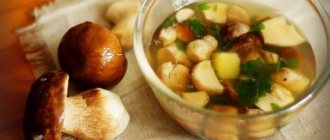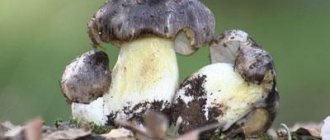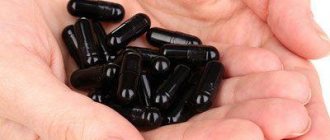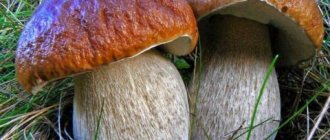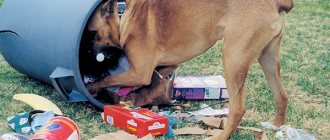It is known that mushrooms are not digested in the stomach of any mammal. Being a heavy product, in addition to the fact that they are not digestible, they can also cause poisoning, allergies, and diarrhea.
Mushrooms contain niacin, some of them are rich in vitamin D, riboflavin, and antioxidants. It would seem that mushrooms are a healthy product, which is even included in some high-quality dry food, but they are not a mandatory product that should be present in a pet’s diet.
You can give them to your dog, but they may cause more harm than good. If your pet likes them, then it is acceptable to occasionally give small quantities of boiled edible mushrooms without spices. Marinated and fried mushrooms with onions, potatoes, spices, and sauce are out of the question. But why give mushrooms to your dog if there are other healthy and safe foods that your pet will eat with great pleasure.
The question “Can I give mushrooms to a dog?” This question is asked by many owners, and it arises in situations where a pet accidentally ate or begged for mushrooms during processing or cooking. In such situations, it is important to understand that a four-legged pet will eat candy, grapes, and drink alcohol, and will not refuse any other tasty but harmful product if she is allowed to eat it. But an owner who cares about the health of a pet will not even think of feeding the animal food that is unhealthy.
Dog owners, feeding this product to their pet regularly, are not aware of the possible consequences, seeing that the pet feels normal. Mushrooms accumulate harmful substances, even those bought in a store; they are not always of high quality. Toxins tend to accumulate in the body, as a result, the dog, several years after including this product in the diet, gets sick or dies, and the thought does not even occur to them that the cause could be mushrooms.
There are many cases of pet deaths as a result of eating mushrooms. Therefore, why risk the health and life of your pet? Even if the dog is begging, it is better to give it a familiar treat, for example, a special cookie, a piece of meat, or cheese.
Mechanism of action
When onions or garlic enter an animal's body, the sulfur compounds contained in these products are absorbed through the gastrointestinal tract into the blood and cause oxidative damage to hemoglobin and red blood cell membranes, which leads to the formation of methemoglobin and the further development of hemolytic anemia with Heinz bodies in the pet.
Constant consumption of these products in low doses by animals also leads to poisoning due to the accumulation of toxic products in the body.
The toxic dose of onion and garlic for dogs is 15-30 g/kg.
The toxic dose of onion and garlic for cats is 5 g/kg.
For puppies
Small pets have a habit of trying everything that catches their eye. Moreover, it is not necessary that this item be edible. Therefore, soft and attractive-smelling mushrooms are a desirable prey for young researchers.
But this product is even more dangerous for puppies than for an adult dog. Due to the completely unformed organism and small mass, even a minimal portion of mushrooms can be very dangerous for them. Dog handlers prohibit giving children mushrooms in general, regardless of the type and method of preparation.
Diagnosis and treatment
If you see your pet eating onions or garlic, you can try to induce vomiting within 30 minutes. To do this, you need to pour table salt on the root of the tongue in a dosage of half a teaspoon for small breeds of dogs and cats to a tablespoon for large breeds of dogs and then pour in a small amount of water. Vomiting should occur within 20 minutes. If the exact time of eating these products is not known, it is necessary to give your pet adsorbents (Enterosgel, Enterozoo, etc.). After providing first aid, immediately go to a veterinary clinic where the animal will be examined.
On the first day after poisoning, a clinical blood test may not show significant changes in indicators, but it is necessary for comparison with the following tests. In a clinical blood test, we will see erythrocytopenia accompanied by reticulocytosis, a decrease in hemoglobin and hematocrit, and sometimes neutrophilia and lymphopenia.
A clinical urine test can detect hemoglobin and bilirubin, since these metabolic products are excreted from the body through the urinary system.
A biochemical blood test reflects an increase in bilirubin levels and a decrease in phosphorus concentration below 0.8 mmol/l.
Abdominal ultrasound may reveal splenomegaly and signs of acute nephritis.
To make a final diagnosis, it is necessary to exclude differential diagnoses: the presence of blood parasites, diabetes mellitus, leptospirosis, poisoning with other toxic substances (paracetamol, vitamin K3, lead, etc.), feline viral leukemia (FLV), genetic predisposition, age-related changes in the body and etc.
Since there is no specific antidote, when signs of poisoning appear, symptomatic treatment is carried out (antiemetics, hematopoietic stimulants, etc.). In severe cases, a blood transfusion and the animal may need to be placed in an oxygen chamber to stabilize the condition.
Late contact with specialists or complete lack of assistance to the animal can lead to death.
Author of the article: Lyudmila Anatolyevna Pushchina, veterinarian, gastroenterologist, therapist.
Author of the article: Lyudmila Anatolyevna Pushchina, veterinarian, gastroenterologist, therapist.
Author of the article: Natalia Vladimirovna Belomyttseva, veterinarian, ornithologist, specialist in exotic animals.
Author of the article: Elizaveta Igorevna Rogozina, veterinarian, anesthesiologist, surgeon.
- cooking (1324)
- Video recipes (478)
- miscellaneous (328)
- cakes (293)
- salads (246)
- baked goods (239)
- main courses (239)
- blanks (82)
- drinks (44)
- Multicooker recipes (3)
- For diary and bloggers (919)
- Musical and poetic compositions (907)
- Parables and other clever thoughts (128)
- do it yourself (811)
- miscellaneous (416)
- modeling (160)
- newspaper weaving (68)
- decoupage (60)
- sewing (52)
- bottle decor (31)
- tildes (27)
- papier-mâché (18)
- salt dough crafts (15)
- topiary (9)
- scrapbooking (8)
- paper art (8)
- kinusaiga (3)
- spot painting (3)
- quilling (2)
- batik (1)
- interesting facts (682)
- beauty, health (671)
- miscellaneous (201)
- facial care (73)
- herbal treatment (66)
- healthy eating (64)
- weight loss (56)
- foot care (50)
- vessels (42)
- hair care (38)
- gymnastics and exercise (32)
- cancer (25)
- hand care (25)
- skin problems (21)
- biologically active points (20)
- body cleansing (19)
- liver (19)
- osteochondrosis (15)
- medicines (14)
- for colds (13)
- diabetes mellitus (12)
- heart (12)
- vision (12)
- hypertension (7)
- back (7)
- thyroid gland (4)
- immunity (4)
- Pancreas (3)
- nerves (1)
- useful tips (381)
- From the lives of famous people (347)
- music (331)
- video (322)
- art (239)
- For creativity (188)
- Funny (150)
- Animals (98)
- Women's things (93)
- My hobby is video editing (72)
- Good movies (52)
- Photo shoots of stars (47)
- Design (42)
- Flash games (6)
Cooking>Unusual and very tasty cheesecakes.
10 recipes for delicious cookies that can be prepared in 15 minutes 10 recipes for delicious cookies.
Cake “Turkish Coffee Shop” What you need: For the sponge cake: 6 eggs 1 cup sugar 3 tbsp.
Cake “Turkish Coffee Shop” What you need: For the sponge cake: 6 eggs 1 cup sugar 3 tbsp.
There is a well-known tradition of not leaving chopped onions, and especially not leaving them overnight, this is known even without a doctorate in chemistry. (Note: This is the first time I’ve heard about this.)
Many times when we suffer from stomach pain because we don't know what the reason is, maybe it is onion. Onions accumulate bacteria, which is so good for preventing colds and chills, but perhaps for the same reason it is best not to eat onions that have been chopped and left for a while and exposed to these same bacteria. The remaining onions are poisonous!
Questions arose during the “epidemic” of food poisoning. One of the brothers, Ed, is a respected chemist in his field. Ed said anyone who has been a victim of food poisoning should remember the last time they ate onions and where. Is it possible that the onion was chopped and not used in time? He explained that onions are a huge magnet for bacteria, and especially raw onions.
Never store any sliced onion in any form or even in the refrigerator. (Note that you are often offered sandwiches with sausage and onions - these onions are dangerous).
Ed adds that if you take leftover onions and cook them for a long time, they may be edible, but if you take raw onions that have been sitting around for a while, you're looking for trouble.
And never feed your dogs onions. Their intestines cannot digest it.
Please be aware that it is dangerous to use chopped onions for cooking the next day. They become poisonous even after one night, they accumulate bacteria that can lead to infection and even toxic food poisoning! Dr. Martin Esther, Biologist and Naturopath
| Categories: | beauty, health/miscellaneous beauty, health/healthy eating interesting facts |
Tags: interesting health
Cited 6 times Liked by: 11 users
Onion and garlic poisoning are common causes of hemolytic anemia in dogs and cats. Domestic carnivores are often given table foods, canned foods intended for humans, and baby meat purees, that is, foods containing onions and garlic. These plants are credited with many healing properties; in the canine literature of the 20th century, there are recommendations to introduce these products into the diet of animals or use them instead of antiparasitic drugs.
The lack of available information in the Russian-language veterinary literature regarding the toxicity of food products for small domestic animals leads to the fact that poisoning with onions and garlic remains undetected, and the developed hemolytic anemia is considered idiopathic. Due to these circumstances, the animal does not receive an antidote, the course of the disease is complicated and it becomes impossible to prevent similar poisonings in the future.
Recipes for cooking dishes with dried champignons
You can quickly make the following soup from dried mushrooms:
- Take 300 g of dry champignons, soak them in water for 10-15 minutes.
- Place the soaked mushrooms in a saucepan, add 3 liters of water, and after boiling, cook for 20 minutes.
- Remove the mushrooms from the broth and transfer to a sieve.
- Fry finely chopped 2 onions and 1 carrot along with mushrooms in vegetable oil.
- Place 3 chopped potatoes in a saucepan with broth, bring to a boil and simmer for 10 minutes.
- Add fried vegetables, salt, pepper, finely chopped parsley and bay leaf to the broth with potatoes, then cook for another 5 minutes.
- It is advisable that this soup steep for about 1 hour.
There are several options for mushroom soup - you can season it with sour cream, at the end of cooking you can add chopped processed cheese, or you can put noodles in the broth along with potatoes.
Toxic substances
From 1994 to 2008, the Veterinary Poisons Information Service (VPIS) reported 69 cases of poisoning of dogs and 4 cases of poisoning of cats from plants of the genus Allium SPP3. All plants of the genus Allium (onion), without exception, are toxic to dogs and cats; their essential oils include allyl propyl sulfide (H5C3S2C3H7) and dipropyl disulfide (H7C3S2C3H7). These are oxidizing substances that transform blood hemoglobin into methemoglobin, which is unable to transport oxygen molecules to tissues. The result of this transformation is hemolytic anemia with the formation of Heinz bodies. Cooked onions contain sodium n-propyl thiosulfate, which acts in a similar way, so cooking and drying them does not make onion plants any less toxic.
Hemolytic anemia from eating plants of the genus Allium has been reported in many animal species, but dogs and cats are most susceptible to poisoning from allium plants. This is due to species characteristics such as low antioxidant activity of catalase in dogs and high susceptibility to oxidative damage to hemoglobin in cats.
Pregnant and lactating
Even if mushrooms in large quantities are contraindicated for a healthy dog, then this product should not be given to females who are bearing offspring in principle.
Previously, there was an opinion that bitches could and even should be given champignons, honey mushrooms, boletuses, chanterelles and saffron milk caps, but now this statement has been refuted.
In case of poisoning, the dog and its offspring are more difficult to tolerate the symptoms, but the risk that the puppies will then be born dead is very high. Therefore, breeders exclude any mushroom supplements from the diet of both pregnant and lactating animals.
Mechanism of action
The sulfur compounds contained in onions and garlic are actively absorbed into the blood from the gastrointestinal tract and, after the concentration of oxidants exceeds the antioxidant capacity of catalase, they cause oxidative hemolysis of red blood cells. The first signs of anemia are observed a day after eating onions, but the most severe anemia develops a few days after this event.
In addition to the main toxic effect, complications associated with the presence of other substances in onion plants are possible. For example, allicin and allisatin, the pharmacologically active substances of onion and garlic, have vasodilatory, antithrombotic and hypotensive effects, and are also powerful muscle relaxants of cardiac and smooth muscles, which increases muscle weakness and impaired oxygen transport in anemia, and can also lead to hypotension. Additionally, the caustic substances in onions and garlic can damage the lining of the stomach and small intestine, causing pain and diarrhea.
Diet for poisoning: what can you eat?
Here is a sample menu for adults in case of poisoning.
First day:
You can't eat, only drink. Salt or herbal infusions.
Second day:
For breakfast, rice water or liquid rice porridge with water.
Gray bread crackers with green tea are suitable as a snack.
For lunch, broth with carrots, onions and thin noodles.
Instead of soup, there can be vegetable puree from potatoes, zucchini, carrots.
For dinner, rice porridge, boiled chicken fillet.
The third day:
For breakfast, cottage cheese casserole, tea with crackers.
For an afternoon snack, banana puree and rosehip infusion. Or biscuits instead of crackers.
For lunch, buckwheat porridge with water, fish cutlets baked in the oven.
For dinner, mashed potatoes without milk, grated carrots, without adding salt, sugar or butter.
Fourth day:
For breakfast, cottage cheese pudding and jelly.
As a snack, crackers or cookies without cream, baked apples.
For lunch, chicken broth, boneless, or vegetable soup with rice,
vegetable casserole with semolina, but without adding eggs.
For dinner, jacket potatoes, steamed veal cutlets.
Fifth day:
For breakfast, soufflé made from semolina or cottage cheese. Biscuits or crackers with chamomile tea.
As a snack, baked pear or jelly.
For lunch, rice or pearl barley porridge. Chicken soup with meatballs, or chicken with steamed vegetables.
For dinner, pureed vegetable soup. For example, from carrots or pumpkin.
Sixth day:
For breakfast, cheesecakes and black tea.
For an afternoon snack, decoction of blueberries, dried fruit or crackers.
For lunch, vegetable soup with pearl barley, veal or steamed chicken fillet.
For dinner, cutlets from lean fish with vegetables.
Seventh day:
For breakfast, buckwheat with grated carrots.
Cottage cheese casserole as a snack.
For lunch, chicken noodle soup, baked pumpkin salad.
For dinner, mashed potatoes with boiled turkey.
Toxicity
Eating onions or garlic in amounts of 5 g/kg body weight for cats and 15–30 g/kg body weight for dogs leads to clinically significant changes in hematological parameters. Toxicosis can develop both with the immediate consumption of onions, and with the accumulation of a toxic substance due to repeated consumption of onions or garlic in quantities less than the toxic dose. It should be remembered that both fresh plant material and food containing boiled onions or garlic (cutlets, soup bags with freeze-dried material, spices) are dangerous. There have been documented cases of cats being poisoned by baby food products containing onions in dehydrated form.
In general, poisoning from onion plants is more severe in cats than in dogs. Treatment with drugs that increase oxidative damage to erythrocytes worsens the condition of animals with onion and garlic poisoning. Such drugs include propofol, methionine, sulfonamides, sulfapyridine, large doses of menadione (vitamin K3, Vicasol), benzocaine, acetaminophen (paracetamol).
Content
1. What are the benefits of mushrooms 2. Should you give them to your dog 3. In what form and how much can you use 4. How to wean them off
Some pets beg their owners for food that seems completely inedible for them. And then the owners have a question: is it possible to give the dog mushrooms, berries and similar foods? On the one hand, the gifts of the forest contain many nutrients beneficial to the body, on the other hand, there is a high risk of digestive dysfunction and the possibility of poisoning. So is it worth indulging your pet’s whims?
Clinical signs
The first signs appear within 24 hours after poisoning and are not specific - vomiting, diarrhea, abdominal pain, anorexia and depression. Within a few days, signs of hemolytic anemia appear: pallor or yellowness of the mucous membranes, rapid, shallow breathing with noticeable effort, tachycardia, lethargy, weakness, sometimes ataxia, dark urine (reddish or brown).
Rare clinical manifestations of onion plant poisoning recorded in the professional literature include bleeding into the chest and abdominal cavity in a cat and hypertension in a dog.
Are mushrooms for cats edible or poisonous?
Forest gifts in the form of mushrooms are divided into edible and poisonous. However, every year many mistakes and poisonings occur, which sometimes end, unfortunately, tragically. Although mushrooms for cats can also be divided into edible and poisonous, knowledge in this area is still so small that it is better not to take risks or experiment. Therefore, all mushrooms should be considered poisonous to cats!
Our furbabies may show some interest in forest delicacies. Of course, not everyone will be interested in what we brought in the basket - some cats completely ignore them. However, the intense smell, the drying process (usually on newspapers), and hanging mushrooms on ropes can tempt particularly curious kittens. Whether it's just for fun or by mistake, there shouldn't be any mushrooms in your cat's tummy!
Diagnostics
On the first day after poisoning, hematological parameters may be normal. After the development of hemolytic anemia, a clinical blood test is most indicative. It reveals anemia with Heinz bodies, sometimes accompanied by neutrophilia and lymphopenia. Hemoglobin and bilirubin can be detected in the urine. A biochemical blood test reflects an increase in bilirubin levels and a decrease in phosphorus concentration below 0.8. Ultrasound diagnostics can reveal an enlarged spleen (splenomegaly) and signs of acute nephritis with renal tubular necrosis. Splenomegaly is observed in almost all cases of anemia with Heinz bodies, since the spleen filters blood to remove old and defective red blood cells from the bloodstream, and with oxidative damage, the number of these increases.
Acute nephritis with tubular necrosis in onion and garlic poisoning is rare and is associated with the excretion of large amounts of hemoglobin or methemoglobin in the urine. Ultrasound signs of acute tubular necrosis (an increase in the resistance index above 0.8) indicate serious, sometimes irreversible damage to the kidney tissue and worsen the prognosis.
What can adults eat if they are poisoned?
When the acute symptoms of poisoning have passed, you can begin to eat small portions.
Products that can be consumed without fear of poisoning include:
- Rice, buckwheat, semolina, boiled in water.
- Rusks from gray bread or loaf. Rusks can be bought in the store, but they must be without any additives, hot spices or herbs.
- Lean cuts of chicken or veal.
- Slimy soups. These are soups with boiled vegetables and cereals. A little later, you can add noodles there.
- Low-fat fish, steamed or baked in the oven. For example, in foil.
- Jacket potatoes.
Differential diagnosis
In order to recognize onion and garlic poisoning as a working diagnosis, evidence of the animal eating these products is not enough; it is necessary to exclude infectious and systemic causes of oxidative hemolysis. In dogs, these are babesiosis, ehrlichiosis, anaplasmosis and leptospirosis. In cats - cytozoonosis and VLK. It should also be remembered that oxidation-sensitive red blood cells in cats can be damaged by any systemic acidosis, and during the initial diagnosis, exclude systemic diseases1, such as diabetes mellitus, especially complicated by ketoacidosis, as well as hepatic lipidosis, hyperthyroidism, lymphoma and other neoplasms.
In representatives of both species of domestic predators, oxidative hemolysis can be caused by dirofilariasis and hemotropic mycoplasmosis (hemobartonella). You should also remember about hemophagocytic syndrome, which can accompany any strong inflammatory reaction of the body and consists in the destruction of the body's own red blood cells by the body's leukocytes due to the presence of antibodies on their membranes. Hemolytic anemia with Heinz bodies may accompany vasculitis (Table 1).
Onion and garlic poisoning should be differentiated from autoimmune hemolytic anemia. Autoimmune hemolysis is characterized by increased ALT, alkaline phosphatase, creatine kinase, prolonged PT and APTT associated with a hypercoagulable state, and the presence of Heinz bodies is uncharacteristic. In doubtful cases, a Coombs test and autoagglutination testing are recommended.
Heinz body anemia can be caused by other toxic substances: lead, zinc, methylene blue, acetaminophen (paracetamol), benzocaine, vitamin K3 (menadione) or phenylhydrazine (found in wastewater from industrial dye manufacturing plants). Anemia with Heinz bodies is caused by hypophosphatemia when the level of phosphorus in the blood is less than 0.32 mmol/l. We should not forget about hereditary red blood cell defects, such as pyruvate kinase deficiency or phosphofructokinase defect. A breed predisposition to pyruvate kinase deficiency has been identified in Abyssinian, Somali, Bengal, Siberian, Norwegian forest cats and Maine Coons. Among dogs, this pathology is recorded in Labradors, pugs, beagles and Basenjis. Spaniels, whippets and mixed breeds of these breeds can suffer from a phosphofructokinase defect. And Somali and Abyssinian cats can exhibit hemolytic anemia due to congenital increased fragility of red blood cells.
Why does he want to eat?
Dogs, especially young and active ones, are very curious and try to taste everything new when walking. It has been repeatedly noted that pets have a special interest in the pale grebe, the stinking fly agaric and toxic fibers. This may be due to their fishy smell.
However, talkers also pose a serious threat, because four-legged animals are very sensitive to muscarine: a dose that does not pose a threat to human life will be lethal for a dog. A common cause of intoxication in dogs are fly agarics, which also have an attractive smell.
How to wean it off?
To avoid unwanted tasting, you should train your dog not to pick up anything from the ground without a command. But if the pet is already an adult, it will be difficult for him to learn this command, so the owner himself will have to demonstrate attentiveness.
The owner must monitor the pet, keep it on a leash in the forest or park, and keep it away from trunks and stumps where mushrooms can grow.
If you live in a private sector, then you need to periodically inspect the area for the appearance of toadstools (especially after rain in the spring-autumn period) and remove them before the dog notices.
Treatment
There is no antidote. On the first day, sorbents are used to stop the absorption of the toxin from the gastrointestinal tract. Ascorbic acid is used as a weak acid to trigger the redox reaction at a dosage of 30 mg/kg every 6-8 hours during the day. Acetylcysteine (ACC) 140 mg/kg - orally as the maximum initial dose, then 70 mg/kg orally every 6 hours 7 more times. This drug is less effective than for paracetamol poisoning, but can be useful because it increases the synthesis of glutathione and activates detoxification processes, and also has anti-inflammatory properties due to the suppression of the formation of free radicals and reactive oxygen metabolites.
In severe cases, a blood transfusion and an oxygen chamber may be required for stabilization. During the recovery period, it is recommended to eat a diet free of potential oxidizing agents, such as the preservative propylene glycol, especially for cats. The effectiveness of treatment in cats is lower than in dogs. Among these animals, death from onion and garlic poisoning is more common, which is why the prevention of these poisonings is so important.
Literature: Salgado BS, Monteiro LN, Rocha NS Allium species poisoning in dogs and cats. The Journal of Venomous Animals and Toxins including Tropical Diseases, 2011. Toxicology Brief: Allium species poisoning in dogs and cats. By R.B. Cope, BSc, BVSc, PhD. Aug 01. Veterinary Medicine, 2005. Cristina Cortinovis, Francesca Caloni. Household food items toxic to dogs and cats. Department of Health, Animal Science and Food Safety, Universitá degli Studi di Milano, Milan, Italy. Front Vet Sci, 22 March, 2020. Kang MH, Park HM Hypertension after ingestion of baked garlic (Allium sativum) in a dog. J Vet Med Sci 2010; 72:515–8. Sturgeon K., Campbell A. A comparison of Allium species poisoning in cats and dogs. Clin Toxicol, 2008. Knight AP A Guide to Poisonous House and Garden Plants. Jackson, ID: Teton NewMedia, 2007.
It is impossible to say exactly when a person first became acquainted with onions. One can only be sure that the first person tried the wild type of onion. By the way, even now in many areas the population uses wild types of onions for food, such as Bear's Onion (ramson), Victorious Onion, Sandy Onion, Strange Onion, Altai Onion.
Green onions were to the taste of ancient man, and our ancestors cultivated them. This is how the homemade onion appeared. Over time, the number of cultivated edible species of green onions has increased. We can easily remember two types of edible homemade onions: Onions, Leeks. These two types are widespread. But there are also, for example, Onion, Moli Onion, Shallot.
Onions began to be grown simultaneously in many territories, starting from Southeast Asia (China), Hindustan (India, Pakistan) and Mesopotamia (modern Iraq) and ending with the Mediterranean countries (Ancient Greece, Macedonia, Ancient Rome).
By the way, in Ancient Rome and Ancient Greece, only wealthy people could afford to eat green onions.
Green onions were also widespread in Ancient Rus'. And even now, it is an integral part of Russian cuisine.
Drinking regime
Intoxication of the body of any kind requires abundant fluid intake. If a person is in absolute health, the volume of liquid should not be less than 2 liters per day, but should be drunk in small portions. In this case, the liquid must be administered some time after eating. If the patient has problems with the heart, kidneys, increased swelling and deterioration in health, the total volume of fluid should not exceed 1-1.5 liters, unless otherwise prescribed by the doctor. The following drinks are suitable after poisoning:
- clean water with lemon;
- weak green tea or black tea with milk;
- compote without sugar;
- berry fruit drinks, infusions;
- decoction of rose hips, infusions of medicinal herbs (chamomile is preferred, stomach teas).
In the first days after intoxication, you should limit yourself to consuming large amounts of liquid. Drinking plenty of warm drinks (the temperature should be comfortable for the mucous membrane of the gastrointestinal tract) helps remove toxins, eliminate the accumulation of pathogenic microflora in damaged areas of the mucous membranes and the onset of the inflammatory process.
Doctors recommend excluding fatty drinking fermented milk products from the diet (ryazhenka, ayran, tan, full-fat kefir, freshly milked milk). It is acceptable to drink low-fat kefir, but not more than 300 ml per day. Carbonated drinks, strong tea, cocoa drinks, and packaged juices are not recommended. Coffee and chicory are also contraindicated after poisoning.
Important! Mineral water can be drunk only after it has been degassed and after the permission of the attending physician. Drinks allow you to restore disturbed electrolyte balance and cope with the negative effects of toxins and other pathogenic components.
What's healthy about green onions?
Green onions contain a large amount of vitamin C. In earlier times, onions were the most necessary anti-scorbutic product. Sailors, setting out on a long journey, might not have taken enough grain with them, but they had to have onions, otherwise scurvy could kill all participants in the voyage. The most important chemicals that make onions so useful are ascorbic acid, which we mentioned earlier, phytoncides, which kill pathogens, and bitters, which have choleretic and anthelmintic effects.
Vitamin C (ascorbic acid) – increases the body’s resistance to various infections. Ascorbic acid is also a strong antioxidant.
Vitamin A (beta-carotene) is an antioxidant. It has a positive effect on vision (due to counteracting free radicals acting on the lens of the eye), improves the condition of the skin, hair, and nails.
Vitamin B1 (thiamine) – has a positive effect on the regulation of the metabolism of fats, proteins and carbohydrates. Thiamine is also necessary for the normal functioning of the human nervous system.
Vitamin B2 (riboflavin) – helps increase the production of red blood cells and antibodies. Necessary for maintaining reproductive functions and normal functioning of the thyroid gland.
Vitamin B9 (folic acid) – essential for protein synthesis processes in the human body. Regulates the activity of the nervous system.
Vitamin E (tocopherols and tocotrienols) are powerful antioxidants and immunomodulators.
Regular consumption of green onions is a must. And that's why.
Green onions also improve appetite. This property is associated with the increased content of bitterness and various organic acids in its composition. Green onions are good for diabetes. The reduction of sugar is facilitated by sulfur compounds that are present in its composition. Green onions are an extremely healthy product that helps diversify dishes during fasting.
Microwave drying
Now almost every home has a microwave oven. Drying champignons in it saves a lot of time. But you just need to put mushrooms in the oven in small portions. The champignons are cut into fairly thin slices and placed on a flat dish. Place the dish in the oven at a power of 100 W, dry the mushrooms for 20 minutes.
Next, take out the dish, drain the melted water, ventilate the mushrooms for 10 minutes and return to the oven for 20 minutes. Repeat the procedure until the mushrooms are ready.
Who should not and who should use green onions with caution?
Green onions are contraindicated for people suffering from gastritis with high acidity and gastric ulcers. In large quantities, green onions increase blood pressure, so they should be used with caution (observe the daily allowance) by hypertensive patients and people suffering from cardiovascular diseases. Although folk medicine lists green onions as a remedy for asthma (and green onions themselves have anti-allergic properties), people suffering from asthma should use green onions with great caution. This is due to the essential oils contained in onions. To protect yourself, you need to treat green onions with boiling water. Then the essential oils will evaporate. Otherwise, green onions can become a catalyst for an attack.
So, green onions are an invaluable product. Eating it is the basis for maintaining health for many years.
Eat green onions and be healthy!
Often green onions and raw onions cause unpleasant, painful sensations in the stomach. The fact is that such products contain substances that, when they get on the mucous membranes of the gastrointestinal tract, cause irritation and strong release of hydrochloric acid, which causes unpleasant symptoms. What to do if your stomach hurts from onions or garlic - read below.
What to do if things get bad?
The most poisonous mushrooms for dogs are considered to be pale toadstool, spring and stinking fly agarics, talkers, sulfur-yellow false honey fungus, false puffballs and poisonous southern boletus mushrooms.
While other mushrooms risk causing mild poisoning, the listed species have a strong toxic effect on the cardiovascular system, central nervous system, gastrointestinal tract, liver, kidneys - almost all vital organs. Poisoning usually has symptoms similar to those in humans:
- constant nausea, vomiting;
- moaning due to abdominal pain;
- diarrhea (usually bloody);
- increased thirst;
- body temperature drops to 35-36°C;
- the pulse is slow and barely detectable;
- inhibited reaction;
- lying down;
- excessive salivation;
- convulsions.
It is necessary to urgently call a veterinarian and be prepared to name the mushrooms that you gave the dog - this will greatly facilitate the treatment process. You should also perform one of the suggested activities yourself:
- rinse your pet’s stomach with water or a pale pink solution of potassium permanganate;
- introduce activated charcoal into the stomach;
- give strong sweet tea, coffee with milk, then give castor oil (from 1 tsp to 100 g, depending on the weight);
- briefly apply a cold compress or a heating pad with cold water to your head.
It is important not to waste time and immediately identify the first manifestations of the problem. Mushrooms have a habit of accumulating in the body, so if you periodically spoil your pet with such food, the consequences may occur even years later. If the owner does not take retaliatory measures, then if poisoned, the dog may fall into a coma or even die.
Onions give me a stomach ache
Typically, consumption of the product in question in moderate quantities in healthy people does not cause any symptoms.
The most common causes of pain after consuming savory vegetables are diseases associated with gastrointestinal dysfunction.
The main reasons causing pain after eating raw onion crops:
- Gastritis is a chronic disease. It is characterized by inflammatory and inflammatory-dystrophic changes in the mucous membranes with impaired regenerative functions. During the course of the disease, some of the epithelial cells and normal glands are replaced by fibrous tissue, under the influence of an increased amount of gastric juice. The progression of the disease leads to deviations in the functionality of the gastrointestinal tract, primarily secretory. The acute phase can be manifested by severe pain, vomiting, and diarrhea. An exacerbation can be caused by a one-time exposure to an irritant - spicy, salty, hot food or the ingestion of chemical irritants or certain groups of drugs into the body.
- An ulcer is a local disorder in the mucous membranes of the gastrointestinal tract, sometimes even involving the submucosal layer. In other words, wound surfaces are formed on the mucous membranes under the influence of hydrochloric acid, pepsin and bile secretions. This disease is characterized by a relapsing course, manifested by phases of remission and exacerbations. Typically, exacerbations occur seasonally (spring and autumn). When the ulcers heal, scars remain on the mucous membranes.
- Poisoning – after poisoning, painful sensations may occur. The fact is that after severe irritation, the mucous membranes need to recover, and under the influence of the substances contained in onions, gastric juice begins to be released faster, which leads to even greater inflammation of the affected tissues.
- Gastroenteritis is a disease that affects the gastric tract and small intestine. It is caused by viruses, E. coli, and other pathogens. It manifests itself more often in an acute form, less often a chronic course is observed. Main symptoms: vomiting, diarrhea, severe pain. With a lesion of this nature, special therapy and a diet are needed that excludes spicy foods, such as bulbous crops. Neglect of these requirements leads to the resumption of symptoms of the acute phase.
- Pancreatitis unites a group of diseases and syndromes characterized by the presence of inflammatory processes of the pancreas. With this disease, enzymes from the pancreas do not enter the duodenum, but begin to act immediately on the spot, which leads to tissue destruction. Treatment of such a disease also involves restrictive diets that exclude spicy foods.
Whether or not it is possible to consume raw onion crops for gastritis and peptic ulcers is decided by the attending physician, based on the individual characteristics of the patient and the intensity of the disease. Many experts recommend introducing the product in question into the daily diet in limited quantities for patients with gastritis, in order to avoid the formation of ulcers on the walls of the gastrointestinal tract. Due to the content of phytoncides and a number of minerals in combination with vitamins, the vegetable has an antibacterial effect, preventing the proliferation of Helicobacter pylori bacteria, which most often provoke the development of the disease. But, when ulcers appear, you should immediately exclude onions from your diet.
During periods of remission for gastritis, it is allowed to introduce fresh onion feathers into the diet as part of salads. You are allowed to eat no more than 50 g per day. At the same time, you need to monitor your health and your body’s reaction to food. If symptoms such as bloating, nausea, belching, or pain occur, you should immediately exclude the product from your diet.
Breed exceptions
There are no comments about individual breeds. But it is worth considering the different parameters of pets.
Large breeds that have an impressive body weight can normally tolerate an inappropriate portion of mushrooms and have at most problems with bowel movements.
But for smaller representatives, especially exotics (Spitz, pug, Yorkshire terrier), eating mushrooms is fraught with the most serious symptoms.
If you notice unusual behavior in an animal, then in the case of tiny four-legged friends you should act especially quickly: breeds weighing up to 3 kg are at risk and require special attention from their owners.
How to eliminate pain and symptoms?
If your stomach starts to hurt after eating onions, you need to take the following steps:
After the intensity of the pain decreases, you should immediately consult a doctor to identify the cause of this condition. If the pain is too severe, you should immediately call an ambulance, because some gastrointestinal diseases may be asymptomatic, and severe pain after consuming onions may indicate serious disorders that cannot be relieved at home.
In the presence of gastrointestinal diseases, consumption of raw onions can cause unpleasant painful sensations and provoke their exacerbation. If you experience bloating, nausea, or cutting pain, you should immediately exclude such food from your menu and seek qualified help from a doctor.
Preparing mushrooms for drying
When drying champignons, the aromatic and taste qualities, as well as useful substances, are preserved; the mushrooms are significantly reduced in size and take up little space during storage.
For drying, it is advisable to purchase fresh, clean, medium-sized champignons. They cannot be washed; they must be wiped with a slightly damp cloth to remove any remaining soil substrate. The darkened areas are carefully cut out with a knife, the lower part of the stem is removed, and rotten specimens are thrown away.
Mushrooms are sorted by size. Small mushrooms are dried whole, and large ones are cut into slices or noodles. The main thing is that the cut parts are not too thick, otherwise they will not dry properly.
